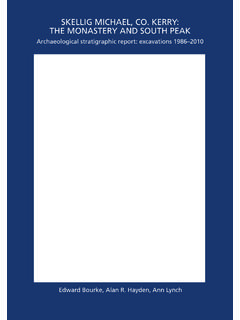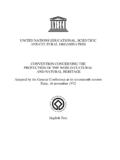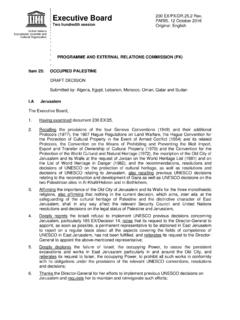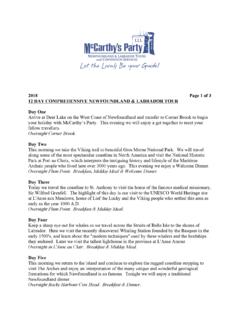Transcription of Leaving Certificate Art History ... - Home | World …
1 Leaving Certificate Art History Education Pack A te acher and student aid to inte rpreti ng th e passage to mbs, archaeology and landsc ape of Br na B inne World Herita ge Si teBr na B inneIntroductionThis education pack has been designed by the Br na B inne guides as an aid for teachers and pupils of the Leaving Certificate Art History syllabus. Br na B in ne World Herit age Sit eKnowthVisitor CentreNewgrangeDowthBr na B inne Archaeological Complex Br na B inne is about eight kilometres inland from Drogheda and describes an area where the river Boyne meanders into a dramatic loop or bend.
2 Br na B inne - The palace or mansion of the Boyne- is the name given to one of the World s most important archaeological landscapes. Today about forty mounds can be seen within the complex, dominated by the three great passage tombs of Knowth, Dowth and recognition of the international importance of this archaeological landscape, the United Nations Educational, Scientific and Cultural Organisation (UNESCO), has designated the Br na B inne area a World heritage Site. Sites selected for World heritage listing are deemed to be of outstanding universal value to humanity and are approved on the basis of their merits as the best possible examples of cultural or natural heritage .
3 The passage tombs, associated monuments and Visitor Centre at Br na B inne are in the care of the Office of Public of the information we have on the monuments at Br na B inne is as a direct result of archaeological investigation. Excavations at Newgrange and Knowth began in 1962 by Professor Michael J. O Kelly and Professor George Eogan respectively. Investigations at Newgrange lasted thirteen years, while those at Knowth lasted nearly showing the position of the monuments within the bend in the Boyne1Br na B inne2 When was the Neolithic period?The earliest inhabitants of Ireland arrived around 8000 BC and were known as hunter-gatherers due to their nomadic lifestyle, hunting local wildlife such as red deer and wild boar, and gathering naturally occurring foodstuffs like nuts and berries.
4 This was the Mesolithic period and lasted from approximately 8000 BC - 4500 4000 BC the gradual introduction of farming techniques from Eastern Europe brought a huge change in lifestyle, this was the beginning of the Neolithic period and was from approximately 4000 BC - 2500 changing landscapeAt this stage in Ireland s History around 95% of the country was densely forested. In order to develop these new farming techniques, stone axes were employed to clear small areas of woodland. Mattocks and wooden ploughs were then used to till the land in preparation for the sowing of crops. Flint knives, scrapers, arrowheads and bone needles were used in day-to-day hunting and domestic work.
5 Crops such as wheat and barley (which were used in porridge and bread making) were cultivated, while the domestication of livestock such as cattle, pigs and sheep or goats was also being developed. Clusters of houses began to emerge, built from upright timber poles faced in wattle and daub and thatched with straw or reeds, leading to the establishment of permanent settlements and a growth in population. Hunting, fishing and foraging continued to be practised and supplemented the farmed importance of the riverThe river must have been an essential resource for this newly emerging farming society.
6 The Boyne, acting almost like a Neolithic motorway, provided transport and communication. However, it also served as a fresh water source for cleaning and drinking while the seasonal migration of salmon would have been a very welcome additional source of food for these opportunistic people. The Boyne Valley provided an excellent environment for these settlements to acquire the wealth, skills and workforce that enabled these early inhabitants to construct their monuments. View of the River Boyne from the Visitor CentreReconstruction of a Neolithic settlement at NewgrangeNeolithic tombsMegalithic tombs can be divided into 4 main classes: Court-tombs, Portal-tombs, Wedge- tombs and Passage-tombs.
7 Br na B inne is exclusively a Passage-tomb landscape, but here are some examples of other types of Neolithic tombs. Court TombsCreggandevesky court tomb, Co. Tyrone Portal TombsKilclooney More portal tomb, Co. Donegal Br na B inne3 What is a passage tomb?The majority of these monuments are known today as passage tombs, they are so called because the structure consists of a narrow passage ending in a small chamber where human remains were found. The passage and chamber is then completely covered in a cairn (circular mound of small stones). The cairn is then enclosed at the base by a series of large slabs known as kerbstones.
8 There are 40 known passage tombs in Br na B inne. Knowth, Newgrange and Dowth dominate the 37 smaller satellite tombs. However, these monuments were not all built at the same time, 4 distinct phases are evident spanning from approximately 3400BC showing location of passage tombs in Br na B inneAs the Neolithic society flourished developing their domestic needs, their attentions soon turned to their spiritual na B inne4Br na B inne5 The passage tomb we know as Newgrange was constructed during the Neolithic period at approximately 3200BC. The cairn covers an area of just less than half a hectare and is around 11 metres high and has an average diameter of 80 metres.
9 The cairn is encircled by 97 greywacke kerbstones and a further 450 similar stones make up the passage and chamber structure. The front section (now restored) is faced with a white quartz wall randomly interspersed with sea-rolled granite boulders. The tomb passage faces towards the Southeast and is 19 metres long. The passage is lined with orthostats, 21 on the right and 22 on the left. The chamber is cruciform or cross-shaped containing 3 recesses or side chambers. The right hand (Eastern) recess is the largest and most decorated, containing 2 stone basins. The roof of the chamber is a corbelled vault, which rises 6 metres above ground level.
10 This is achieved when large slabs are placed one on top of the other narrowing like a dome as they ascend, until finally a single stone or capstone closes off the structure. Newgrange before and after ReconstructionMaterials and construction Great effort and time was needed for the planning, gathering of materials and construction of these monuments. This is clearly evident from the vast distances the builders travelled to acquire the particular stone types. The majority of structural stones in the Boyne Valley tombs are greywacke. This stone type was quarried in the Clogherhead area, north of Drogheda and shipped along sea and river, then finally logrolled from a docking point on the Boyne up to the construction area at Newgrange.







